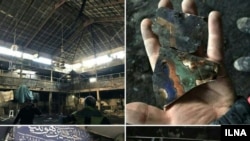There is no doubt that a human factor has been responsible for burning an old Hossainyeh in Tehran’s northern neighborhood, Shemiranat, the local governor has confirmed.
Hossainyeh is a congregation hall for Shi’a commemoration ceremonies, especially those associated with the “martyrdom” of Hossain ibn Ali, Shi’ites’ third Imam.
Flammable liquids were thrown into the Hossainyeh on Thursday morning, December 27, which damaged the 70% to 80% of the interior.
The Hossainyeh, located at Darake district of Shemiranat was equipped with CCTV that has filmed two saboteurs riding a motorbike near the compound at the time of the incident, state-run Iran Labor News Agency, ILNA reported on Friday, December 28.
“Though the building has not been much damaged but, the carpets, instruments, books and other things inside it have been burned down”, Khan Mohammadi noted.
However, according to Shemiranat’s director of Cultural Heritage and Tourism Department, Mohammad Inshaei, “Darakeh’s Hossainyeh is a contemporary building that has no significant cultural value. Nevertheless, there were some old relics inside it that have all burnt”.
Three months earlier, in similar attacks “Javad ul-A’immeh” mosque and several banks in Tehran were also set ablaze by arsonists.
A day after it was disclosed that people responsible for attacking “Javad ul-A’immeh” mosque had been arrested, a video clip circulated in social-media showing the gate of Ali ibn AbiTalib mosque in city of Tabriz, northwestern Iran, on fire.
Tehran’s police chief, the Islamic Revolution Guards Corps’ (IRGC) General Hossein Rahimi said at the time, “A number of young people encouraged by cyberspace and satellites’ TV shows are responsible for attacking, banks, ATM machines and mosques”.
The related videos circulated in social media, show an attacker writing the term “Restart” on the mosque’s wall and then, using flammable liquids, puts the gate of Ali ibn AbiTalib mosque on fire. The videos end, while somebody chants, “Viva Hosseini”.
Hosseini is the family name of a self-exiled former showman of the Islamic Republic’s official TV network.
The former comedian and showman, who has left the country, has recently launched “Restart”, a campaign calling upon people, especially the youth, to attack government owned centers, including banks, mosques, Hossainyehs and Baseejis’ barracks. (Baseejis are members of an IRGC force and mainly plainclothesmen deployed to suppress dissidents and protesters).
“Restart” style attacks have not been limited to places in Iran. On Saturday, October 16, two persons were arrested, charged with arson against the Islamic Republic’s embassy in London.
Based on an IRNA report, the detainees had written the term “Restart” on the embassy’s main door but police arrested them before any fire was started.
A video, a copy of which was sent to Radio Farda, shows a person spraying the word “restart” on the embassy’s main entrance and then throws stones at the building.
However, it is not yet clear whether the arson attack on Darakeh’s Hossainyeh is also related to Mohammad Hosseini’s “restart” campaign.





